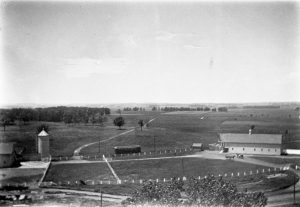Electric Trolley Line Had a Convenient Stop in Huntley from 1905-1930
Some called it the streetcar. Some called it the trolley. Others referred to it as the third rail. It was known as the E&B or even “Arnold’s Folly” after its owner. It was officially the Elgin & Belvidere Electric Company and it ran an interurban electric line between the two cities with stops at Gilberts, Huntley, Coyne Station and Marengo.
At its height, the trolley ran in both directions numerous times daily beginning before 6 a.m. and continuing until midnight.
The line ran parallel to the Chicago and North Western Railroad tracks, but the fare for riding the trolley was much less than taking the train.
The leg of the route from Elgin to Belvidere was called “The Dairy Route,” traveling through the abundant farmlands and often collecting milk cans for transport to processing plants.
Construction of the line began in 1905. Powerhouses to supply the electricity for the trolleys were constructed along the line, with the main shop situated at Marengo.
The Huntley station was located on the north side of West Main Street, west of what is now Route 47.
From Huntley, it would cost 5 cents to ride west to Coyne Station, 25 cents to get to Marengo, and 50 cents all the way to Belvidere. In the other direction, a quarter would get a rider to Elgin.
At a time when travel was not easy, the interurban line provided a convenient means to visiting, shopping and jobs in larger communities.
It carried baseball teams and hometown fans to games between communities along the line. It transported troops into Chicago during World War I. It brought the evening newspapers from Elgin. It carried crowds bound for the picnic groves in Huntley.
But the line was plagued with accidents. Many were due to livestock wandering on the tracks, autos or wagons stopping in front of the interurban cars, mechanical failure or human negligence.
While the streetcar was an asset to the communities it served, it was not financially successful. The Elgin & Belvidere Electric Company had only three profitable years in its nearly 25 years of operation.
The growing popularity of automobiles, improved highways and the advent of bus service added to the decline of the interurban.
On March 9, 1930, the E & B line ceased operation. The book The Dairy Route: The History of the Elgin & Belvidere Electric Company by Carl F. Gustafson tells a more detailed story of the interurban line. The book is available at the Huntley Library for in-library reference and review.
